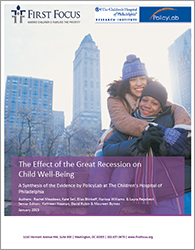 Earlier this week First Focus and Policylab of the Children’s Hospital of Philadelphia released The Effect of the Recession on Child Well-Being, which analyzes the lingering effects of the recession on four areas of child well-being: health, welfare, nutrition, and housing stability. This report is an update to a 2010 analysis also done by Policylab.
Earlier this week First Focus and Policylab of the Children’s Hospital of Philadelphia released The Effect of the Recession on Child Well-Being, which analyzes the lingering effects of the recession on four areas of child well-being: health, welfare, nutrition, and housing stability. This report is an update to a 2010 analysis also done by Policylab.
It may not be a surprise that the effects of the recession are still lingering for many children and families. 14.7 million children are still living in poverty, an increase of almost 2 million children since the start of the recession. Child homelessness is also on the rise – 1.2 million homeless students were identified by the Department of Education in the 2012-2013 school year, which is an 85 percent increase since the start of the recession. 38 percent of children living in families that face a severe housing cost burden – meaning their housing costs consume at least half of their monthly income.
The good news is that the report illustrates that programs such as the Supplemental Nutrition Assistance Program (SNAP) prevented millions of additional children from falling into poverty during the recession. This program worked as it should – participation expanded during the toughest years of the recession, and then began to reduce as the recovery started. Since 2013, SNAP participation rates have been dropping in the majority of states.
Another example is in the area of children’s health – due to Medicaid and the Children’s Health Insurance Program (CHIP), the number of uninsured children dropped by 600,000 in the first two years of the recession, and as of 2013, the uninsurance rate for children was just 7.3 percent in 2013, the lowest point in decades.
Yet we know that millions of children and families are still struggling – so what can we do to help mitigate the effects of the Great Recession for children and families?
Continue what works
We need to extend the Children’s Health Insurance Program (CHIP) before funding expires on September 30, 2015. Last year, CHIP provided funding for 8.4 million children across the country and since it was established, it has cut the uninsured rate for children by more than half.
Reauthorize the Child Nutrition Act and defend the important gains made in the Healthy, Hunger Free Kids Act in 2010 to ensure kids have access to nutritious, healthy food. The Child Nutrition Act provides about 30 million lunches and 13.5 million breakfasts to students every school day along with 3.5 million children in child care centers and 6.8 million infants and children through the Special Supplemental Nutrition Program for Women, Infants and Children (WIC) program.
Streamline services for homeless children and families
The Homeless Children and Youth Act (HR 576/S 256), sponsored by Representatives Steve Stivers (R-OH-15), Rodney Davis (R-IL-13) and Dave Loebsack Rodney Davis (D-IA-2), would align the definition of homelessness used by the Department of Housing and Urban Development with the definition used by the Department of Education, thereby allowing millions of homeless children and youth to access critical assistance such as transitional housing and wraparound services.
Create a national target to reduce child poverty
Creating a national target to reduce child poverty is not unprecedented – the United Kingdom established a target in 1999 and through a mixture of investments for children, measures to make work pay, and efforts to increase financial support for families, using an absolute measure of poverty they cut their child poverty in half by 2009. A national child poverty target can serve as a rallying cry for the government and other stakeholders to take concrete steps to reduce child poverty in the US. It institutionalizes the goals of reducing child poverty and serves as an impetus for public debate around the most effective interventions needed to achieve this target.
Collect better data
Federal data systems suggest that overall child maltreatment rates declined during and after the recession, while hospital-sourced data indicates an increased incidence of the most serious types of child maltreatment. Lawmakers should take a closer look at how the federal government collects child abuse and neglect data, in light of the conflicting picture painted by hospital data, so we can have a true understanding of the problems kids are facing, and how to solve them.
